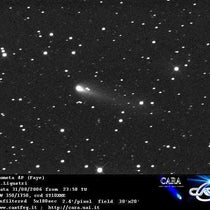Scientist of the Day - Hervé Faye
Hervé Faye, a French astronomer, was born Oct. 1, 1814, in Indre, in central France. He attended the École Polytechnique in Paris and there discovered astronomy, which he would make his life's work. He was hired by the Paris Observatory as a staff astronomer.
It was in the fall of 1843, when he was 29 years old, that he made a discovery to which his name was immediately attached, and still is. On Nov. 22, 1843, he spotted a very faint comet in a Paris Observatory telescope. He recorded its position, and it was still there two days later, when the skies cleared, and like a good comet, it had moved. Faye soon determined that it was on its way away from the Sun (meaning its closest approach to the Sun had gone unobserved. It was soon discovered that its orbit was not parabolic but elliptical, meaning the orbit was closed and it would retrace its path. It was a periodic comet, circling the Sun every 7.4 years in the space between Jupiter and Mars.
The first periodic comet identified as such was Comet Halley, the comet of 1682, which Edmund Halley (in 1705) predicted would return in 1758/59. When it did, astronomers knew for the first time that at least some comets are periodic.
The second periodic comet was first observed in 1786, but not until 1819 did Johann Encke show that it was periodic, circling the Sun in 3.3 years. The third was identified as periodic by Wilhelm von Biela in 1826. Faye's comet of 1843 was just the 4th periodic comet discovered.
The practice now is to label comets with a number in the order of their discovery. If a comet is periodic, then the letter "P" is added, and so is the name of the person who determined it is periodic. By those rules, comet Halley is 1P/Halley, Encke’s comet is 2P/Encke, Biela's was 3P/Biela (and now 3D/Biela, since it broke apart), and Faye's comet is 4P/Faye. Faye, not yet 30, was famous, and fêted, for his fortuitous find. Hundreds of periodic comets have been discovered since, but no one much cares about 138P/Shoemaker-Levy, even though the discoverers were well-respected astronomers. But to have 4P on your resume, that is inviting election to the astronomical hall of fame. Faye was pretty much set for life. To his credit, Faye did not rest on his comet laurels (which you can see displayed on his chest in his portrait), and he had a respectable later career as an astronomer. We have several of his books, published in the 1880's, including one called Sur l'orígine du monde: Théories cosmogoniques des anciens et des modernes (1884), on the history of attempts to explain the origin of the visible universe since ancient times, which looks interesting (fourth image).
Faye died in 1902, but his comet, being periodic, kept returning, bringing his name back into the astronomical limelight every 7.4 years. Some appearances have been better than others. Apparently 2006 was a good year, as there are several photographs of Faye's comet from that year posted online; we include one here (first image).
My favorite feature of Faye's entire career is that his picture appeared on a chocolate card in 1900 (second image). Most cards included in packs of tea, tobacco, and chocolate at the turn of the century portrayed actors, writers, and sports figures, since that is what collectors wanted; it was not common for scientists to be included. So I am sure Faye was pleased to be on a card. The first card series of 1900, the one including Faye, issued by Felix Potin, chocolatier, included 500 portraits, so there must have been other scientists portrayed, but you probably had to buy quite a few packets of chocolate to find one.
William B. Ashworth, Jr., Consultant for the History of Science, Linda Hall Library and Associate Professor emeritus, Department of History, University of Missouri-Kansas City. Comments or corrections are welcome; please direct to ashworthw@umkc.edu.










